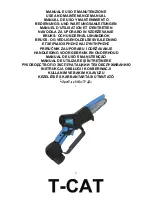
Three-prong plug
Grounding prong
Properly grounded outlet
WARNING!
In case of a malfunction or breakdown, grounding provides a path of least
resistance for electric current to reduce the risk of electric shock. This tool is
equipped with an electric cord having an equipment-grounding conductor and
a grounding plug. The plug must be plugged into a matching outlet that is properly
installed and grounded in accordance with all local codes and ordinances.
SAFETY GUIDELINES
SAFETY GUIDELINES
11
10
model no. 055-6789-8 | contact us 1-800-689-9928
WARNING!
•
Use the proper extension cord. Make sure to use an extension cord that is
heavy enough to carry the current required by the tool. An undersized cord will
cause a drop in line voltage, resulting in loss of power and overheating of the
tool.
•
Use the extension cord only for intended purpose. DO NOT pull the extension
cord to remove it from the power socket.
CAUTION:
In all cases, verify that the outlet in question is properly grounded. If you are not
sure, have a licensed electrician check the outlet.
USE SAFETY GOGGLES AND EAR PROTECTION:
ALWAYS WEAR EYE PROTECTION THAT CONFORMS WITH CUL REQUIREMENTS. FLYING
DEBRIS can cause permanent eye damage.
The tool is loud and the sound can cause hearing damage. Always wear ear protection to help
prevent hearing damage and loss. Failure to comply may result in moderate injury.
USE DUST MASK:
Some dust created by sawing contains chemicals that are known to cause cancer, birth defects
or other reproductive harm. Some examples of these chemicals come from lead-based paints;
crystalline silica from bricks, cement and other masonry products; and arsenic and chromium
from chemically treated lumber. To reduce exposure to these chemicals, work in a well-ventilated
area with approved safety equipment, such as dust masks that are specially designed to filter out microscopic
particles.
POSITION OF TILE SAW
•
To avoid the possibility of the appliance plug or
receptacle getting wet, position tile saw to one side of
a wall-mounted receptacle to prevent water from
dripping onto the receptacle or plug. The user should
arrange a "drip loop" in the cord connecting the saw
to a receptacle. The "drip loop" is the part of the cord
below the level of the receptacle, or the connector if
an extension cord is used, to prevent water travelling
along the cord and coming into contact with the
receptacle.
•
If the plug or receptacle does get wet, DON’T unplug
the cord. Disconnect the fuse or circuit breaker that
supplies power to the tool. Then unplug and examine for presence of water in the receptacle.
ELECTRICAL SAFETY
•
Do not modify the plug provided – if it will not fit the
outlet; have the proper outlet installed by a qualified
electrician.
•
Improper connections of the equipment-grounding
conductor can result in a risk of electric shock. The
equipment-grounding conductor is the insulated
conductor that has an outer surface that is green,
with or without yellow stripes. If repair or replacement
of the electric cord or plug is necessary, do not
connect the equipment-grounding conductor to a
live terminal.
•
Check with a qualified electrician or service personnel
if the grounding instructions are not completely
understood, or if in doubt as to whether the tool is
properly grounded.
•
Use only 3-wire extension cords that have 3-prong
grounding plugs and 3-pole receptacles that accept
the tool’s plug.
•
Repair or replace a damaged or worn cord
immediately.
•
Use only three wire extension cords that have three
prong grounding plugs and three pole receptacles
that accept the tool's plug, as shown in Fig. 2.
Tool
Drip loop
Fig. 1
Supporting surface
Power supply
cord
Fig. 2
GROUNDING INSTRUCTIONS
In order to prevent potential electrical shock and injury, the following electrical safety precautions and symbols
should be followed at all times!




































